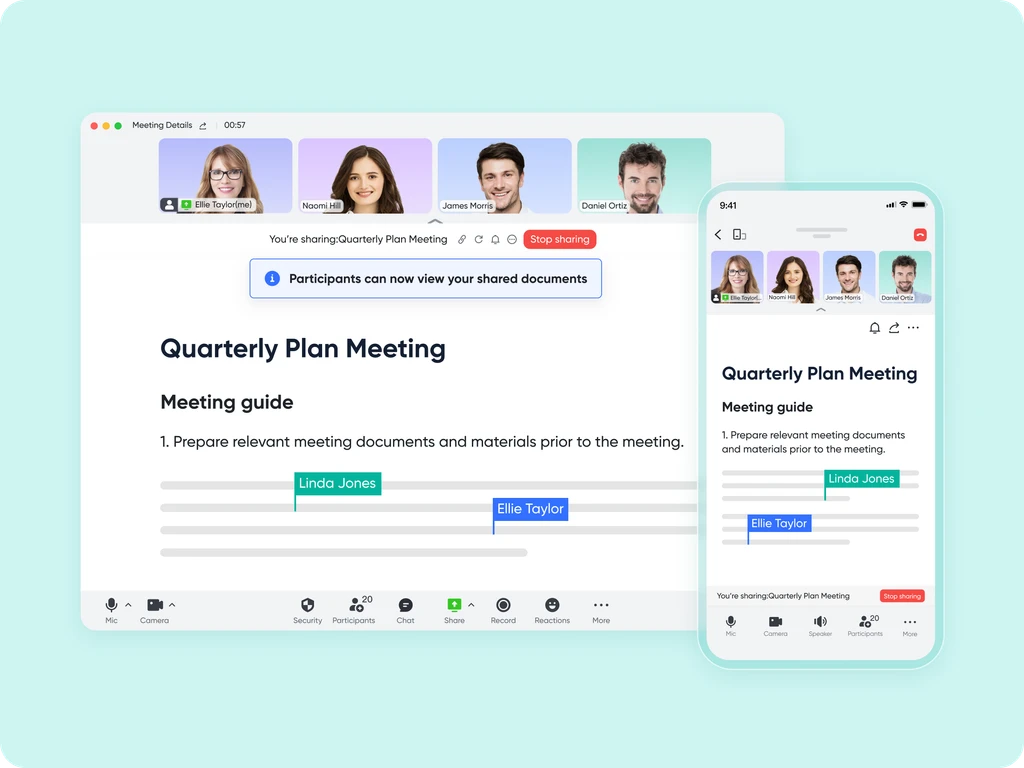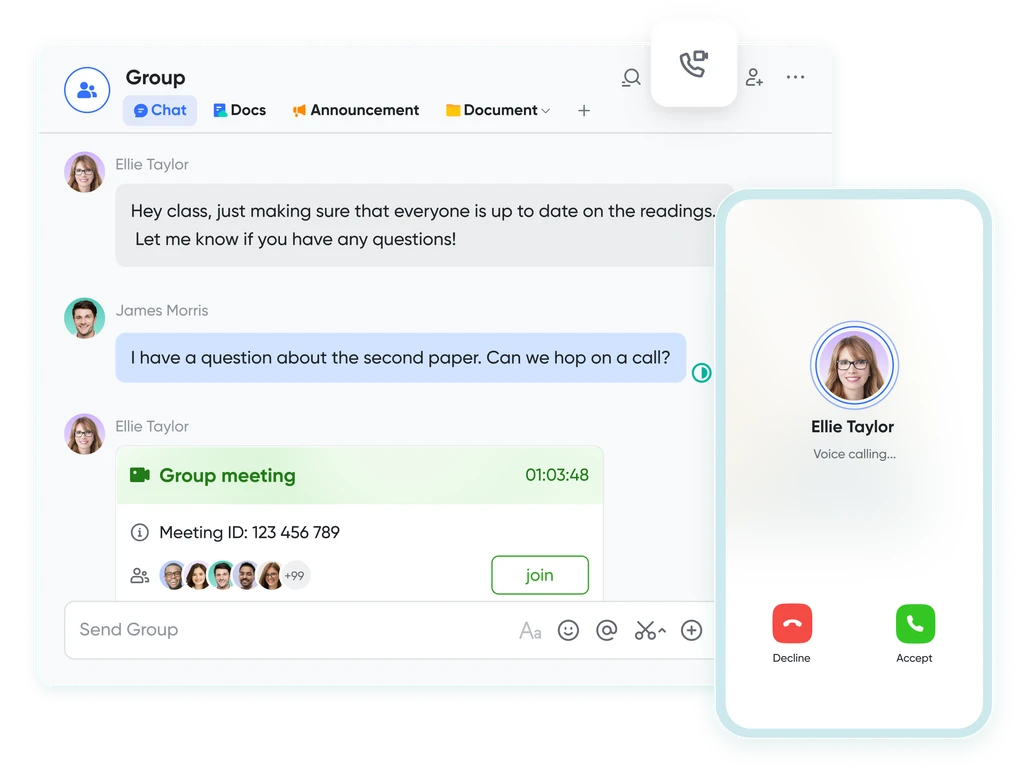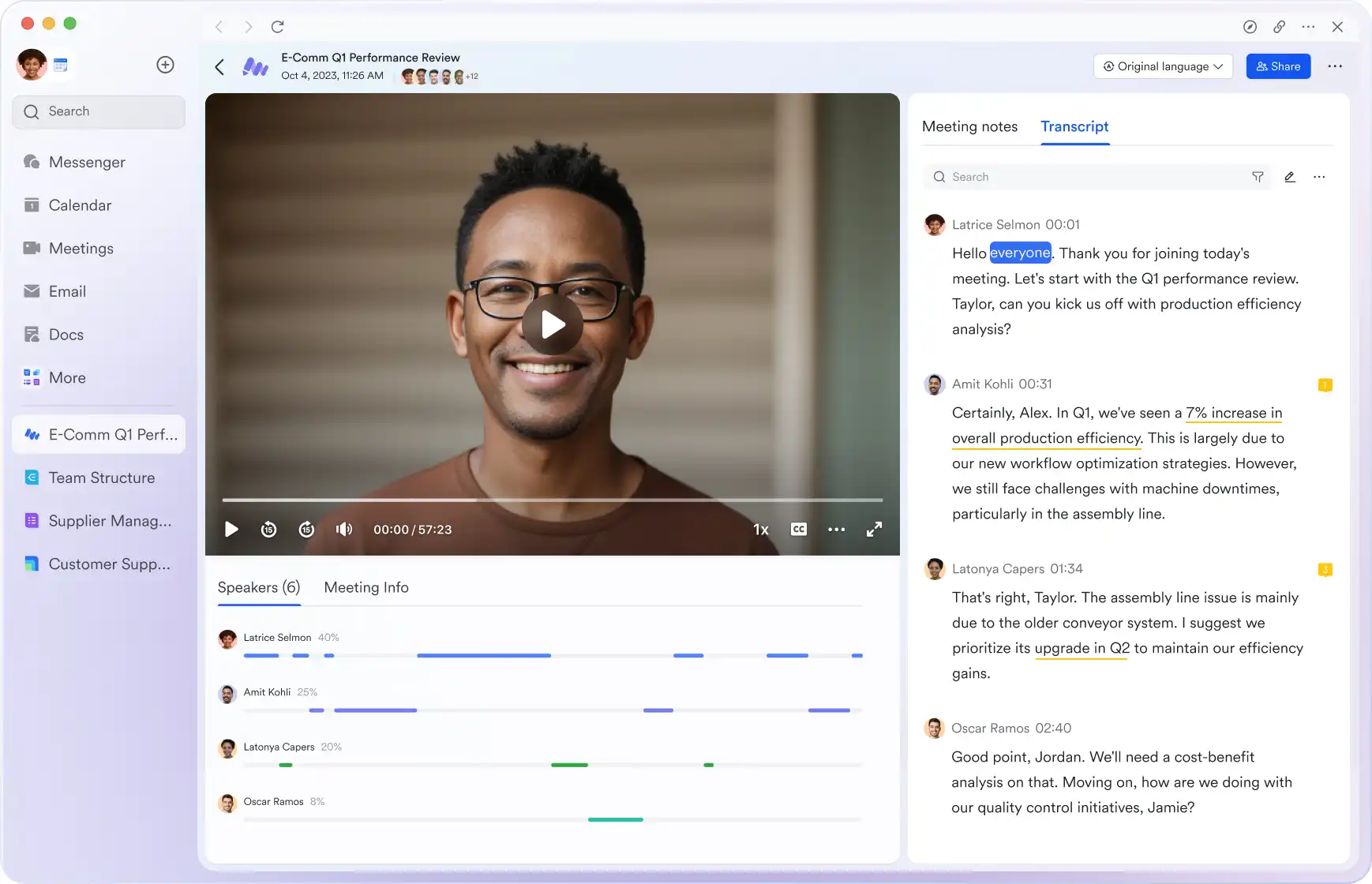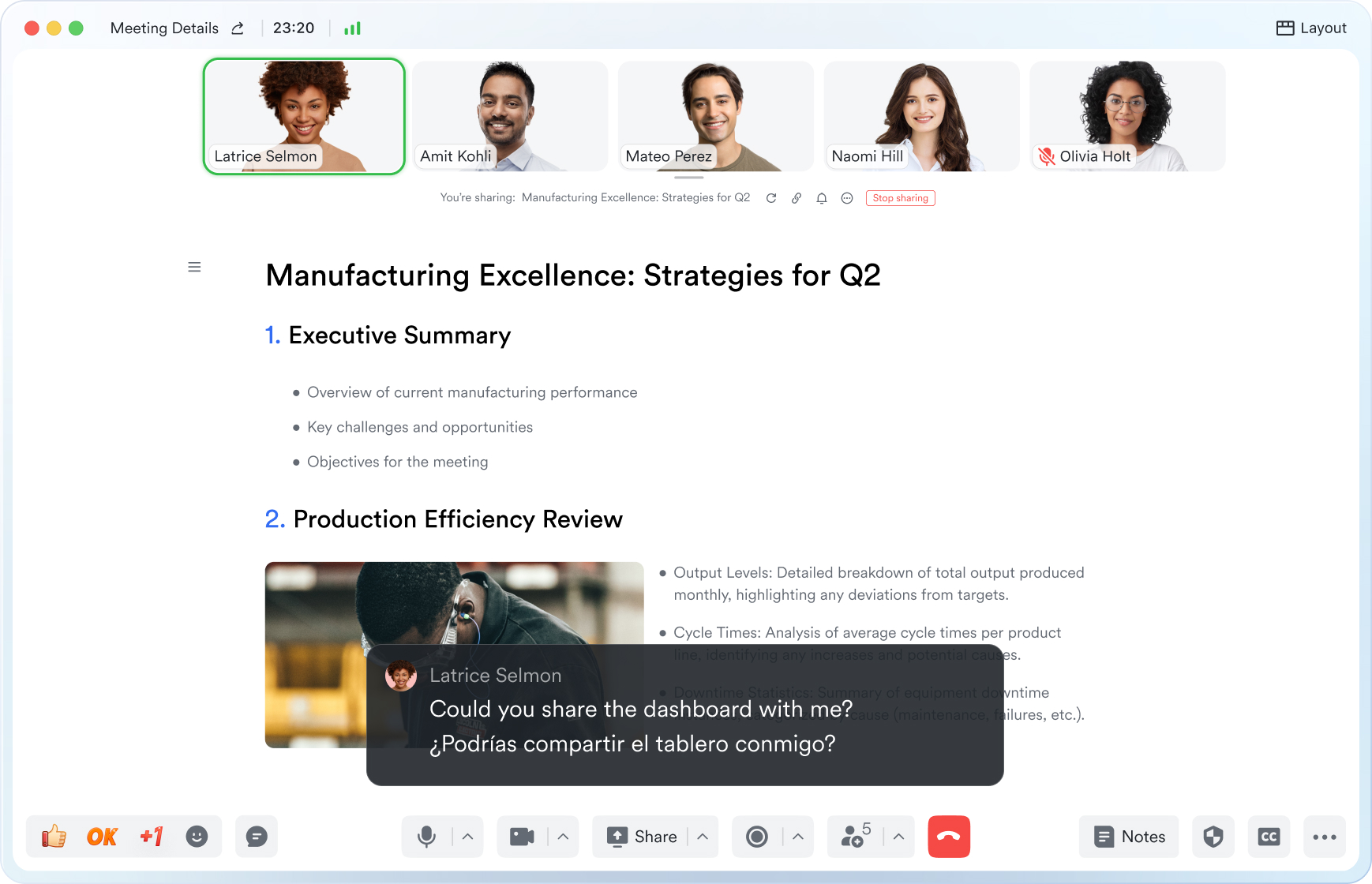Networking Meeting
This guide will walk you through the essential elements of use networking meeting to keep your attendees aligned and engaged.
Try Lark for Free
In today's interconnected professional landscape, the ability to host a successful networking event is a valuable skill that can open doors to meaningful collaborations and career opportunities. This comprehensive guide will provide insights, tips, and practical examples to empower you in running a successful networking meeting in 2024 and beyond.
Use Lark Meetings to turn meetings into true collaborative experiences.
What is a networking meeting?
Networking meetings are structured gatherings that bring together professionals from diverse industries and backgrounds to foster meaningful connections, share knowledge, and create potential business opportunities. These meetings can be in-person or virtual, providing a platform for individuals to expand their professional network and build relationships. In the digital age, networking meetings have evolved to incorporate advanced communication technologies, enabling participants to connect regardless of geographic locations.
Goals of networking meeting
- Building Professional Relationships: Networking meetings serve as a platform for individuals to establish and nurture valuable professional connections, which can lead to collaborations and career opportunities.
- Knowledge Sharing and Learning Opportunities: These meetings facilitate the exchange of industry insights, best practices, and expertise among participants, contributing to professional development.
- Creating Business Opportunities: By fostering connections with diverse professionals, networking meetings can create avenues for potential partnerships, projects, and business ventures.
- Personal Branding and Visibility: Participation in networking meetings enables individuals to showcase their expertise, expand their influence, and enhance their professional visibility within their respective industries.
Who should attend networking meeting?
Networking meetings are designed to accommodate individuals from various professional backgrounds, including:
- Entrepreneurs and Business Owners
- Corporate Professionals
- Industry Experts and Thought Leaders
- Emerging Professionals and Graduates
- Creatives and Freelancers
It is essential to encourage diversity in attendees, encompassing individuals from different genders, ethnicities, and career stages, to create a rich and inclusive networking environment that fosters varied perspectives and opportunities.
Related:
Master the Art of Meeting Notes with Lark for Enhanced Collaboration | Lark Blog | Lark BlogLearn more about Lark x Meetings
Topics, agenda, and structure of networking meeting
To ensure a successful networking meeting, it is crucial to establish clear objectives, craft an engaging agenda, and create a structured format. The following elements are essential for designing an effective networking meeting:
- Setting Clear Objectives: Define the desired outcomes of the networking meeting, whether it is to establish new connections, share industry insights, or explore collaborative opportunities.
- Crafting an Engaging Agenda: Develop a well-organized agenda that balances networking activities, interactive sessions, and knowledge-sharing opportunities to keep participants actively engaged throughout the meeting.
- Creating a Structured Format: Establish a framework for the meeting, incorporating time for introductions, facilitated discussions, and opportunities for open networking.
By incorporating these elements, the networking meeting can provide a holistic experience for participants, encouraging meaningful interactions and value creation.
Learn more about Lark x Meetings
How often does a networking meeting occur?
The frequency of networking meetings can vary based on industry norms, organizational requirements, and the intended outcomes of the gatherings. While some networking meetings occur on a monthly or quarterly basis to maintain regular interactions and relationship-building, others, especially larger events, may be annual or biennial occurrences. It’s important to strike a balance between regularity and the meaningful engagement of participants.
Key differences between networking meetings and similar gatherings
Networking meetings differ from social events, professional conferences, and seminars in several key aspects:
- Networking vs. Social Events: Networking meetings are focused on creating professional connections and exploring collaboration opportunities, while social events prioritize informal interactions and relationship-building in a more relaxed setting.
- Networking Meetings vs. Conferences: Networking meetings often cater to a smaller, targeted audience, fostering deeper connections and discussions, whereas conferences are larger-scale events with diverse sessions and formal presentations.
- Networking Meetings vs. Seminars: While seminars are centered around educational presentations, networking meetings emphasize interactive discussions, relationship-building, and industry insights.
Understanding these distinctions is essential for effectively designing and positioning networking meetings within the professional landscape.
Related:
Unlock the Power of Webinars: A Comprehensive Guide to Boost Your Business | Lark Blog | Lark BlogLearn more about Lark x Meetings
Three practical examples of successful networking meetings
In-person networking event
In-person networking event
An in-person networking event was organized by an industry association, bringing together professionals from various sectors to foster collaborations and share industry insights. The agenda included facilitated discussions, guest speakers, and interactive networking sessions, resulting in new partnerships and heightened engagement among attendees.
Industry-specific virtual networking session
Industry-specific virtual networking session
A virtual networking session was hosted by a technology consortium, catering to professionals in the IT and digital transformation space. Through advanced virtual platforms, interactive breakout rooms, and tailored discussions, the virtual networking session facilitated meaningful connections and knowledge exchange, transcending geographical barriers and time zones.
Hybrid networking meeting with a global reach
Hybrid networking meeting with a global reach
A global trade alliance organized a hybrid networking meeting, combining in-person gatherings across different regions with synchronized virtual components. This allowed participants from diverse locations to engage in simultaneous discussions, form global connections, and explore international business opportunities, demonstrating the potential of hybrid formats in fostering comprehensive networking experiences.
Common pitfalls of networking meetings
Successfully executing a networking meeting requires careful planning and consideration to avoid common pitfalls, including:
- Overlooking Diversity and Inclusivity: Failing to create an inclusive environment that welcomes individuals from diverse backgrounds and perspectives can limit the networking meeting's potential impact.
- Lack of Structured Agenda and Purpose: Networking meetings without a well-defined agenda or clear purpose may result in disengagement or a lack of meaningful interactions among participants.
- Neglecting Post-event Engagement: Inadequate follow-up strategies and post-event engagement can diminish the long-term impact of the networking meeting, hindering the development of lasting connections and collaborations.
Identifying and addressing these pitfalls is essential for ensuring the success and effectiveness of networking meetings.
Related:
Master the Art of Meeting Notes with Lark for Enhanced Collaboration | Lark Blog | Lark BlogLearn more about Lark x Meetings
Do’s and don’ts of networking meetings
In the context of networking meetings, it is essential to observe certain best practices while avoiding potential pitfalls. The following table outlines the key do’s and don’ts to consider for successful networking events:
| Do | Don't |
|---|---|
| Foster genuine conversations and connections | Oversell or push personal agendas |
| Follow up with new connections for continued engagement | Monopolize conversations and neglect others' contributions |
| Ensure inclusivity and diversity in networking activities | Disregard time management, leading to disorganized interactions |
| Showcase expertise and value through meaningful exchanges | Underestimate the importance of post-event engagement and relationship-building |
By adhering to the do’s and avoiding the don’ts, hosts and participants can contribute to the success and overall positive impact of networking meetings.
What makes a virtual networking meeting successful?
Hosting a successful virtual networking meeting involves leveraging advanced digital technologies, fostering meaningful connections in a digital environment, and overcoming the unique challenges of virtual interactions. By utilizing advanced video conferencing platforms with dedicated networking features, interactive virtual collaboration tools, and AI-driven networking solutions, hosts can create personalized and impactful virtual networking experiences. Nurturing meaningful connections and engagement in the virtual space is essential for the long-term success of virtual networking meetings.
Learn more about Lark x Meetings
Typical takeaways from networking meetings
Participation in networking meetings can yield various valuable takeaways for the attendees, including:
- Building Professional Relationships: Networking meetings provide a platform to nurture valuable professional connections, leading to potential collaborations and career opportunities.
- New Industry Insights and Knowledge: Participants gain access to industry-specific information, best practices, and knowledge shared during the networking meeting, contributing to their professional development.
- Potential Collaborations and Business Opportunities: The networking environment often presents avenues for potential partnerships, projects, and business ventures, which can arise from the connections made during the meeting.
These typical takeaways highlight the significance of networking events in facilitating professional growth and expanding opportunities.
Questions to ask in a networking meeting
Striking up meaningful conversations during a networking meeting can be facilitated by asking relevant and engaging questions. Some key categories for potential questions include:
- Icebreaker and Introductory Questions: Conversation starters centered around professional interests, industry backgrounds, or common professional challenges.
- Industry-specific Inquiries: Discussions focusing on emerging trends, best practices, or notable developments within specific industry sectors.
- Relationship-building Queries: Questions aimed at understanding the professional objectives and potential collaboration interests of the attendees.
Facilitating these types of questions can contribute to enriched networking experiences and valuable interactions among participants.
Learn more about Lark x Meetings
Conclusion
In conclusion, hosting a successful networking meeting involves meticulous planning, inclusive engagement strategies, and a focus on fostering genuine connections and knowledge exchange. As networking meetings continue to adapt to the evolving professional landscape in 2024 and beyond, the ability to navigate in-person and virtual interactions while maximizing the value for all participants is set to play a crucial role in professional growth and development.
Use Lark Meetings to turn meetings into true collaborative experiences.
A Game Changer for Networking Meeting: Empower your team with Lark Meetings
In the fast-paced and dynamic world of modern business, effective communication and collaboration are crucial for success of Networking Meeting. Here we introduce Lark Meetings to serve as a centralized hub for all communication needs.
Transform your meetings into collaborative endeavors

Leverage the potency of in-call document sharing, intelligent meeting minutes, and mobile-optimized features to enhance productivity collaboratively, irrespective of your location or schedule.
Seamlessly collaborate in real-time, across any device

Share live documents instead of just screen views. Participants can navigate and edit simultaneously within the video call window, even while on the move.
Shift your focus to engagement, not note-taking

Lark Minutes automatically converts video meetings into transcripts, facilitating easy viewing, searching, and collaborative editing. Stay in the loop asynchronously, even if you can't attend the live meeting. Lark Minutes for meeting minutes support translation into 10+ different languages.
Break language barriers in communication

Lark Meetings provide real-time translation for subtitles, allowing individuals from diverse backgrounds to express themselves in their native languages. Ensure every voice is heard, regardless of geographical location. Live subtitles currently support translations from English, Chinese, and Japanese to 10+ different languages. See more translation feature in Lark.
Connect with larger audiences
Host dynamic online meetings and events accommodating up to 1,000 participants, with the flexibility of up to 50 breakout sessions for intimate group discussions within the larger meeting context. Try more Lark features for free.








